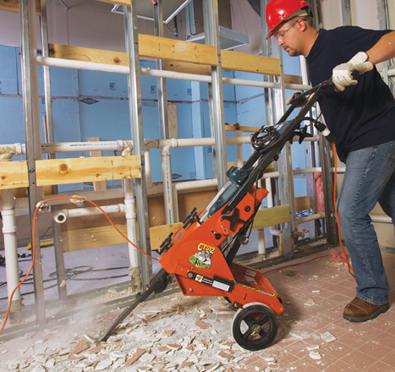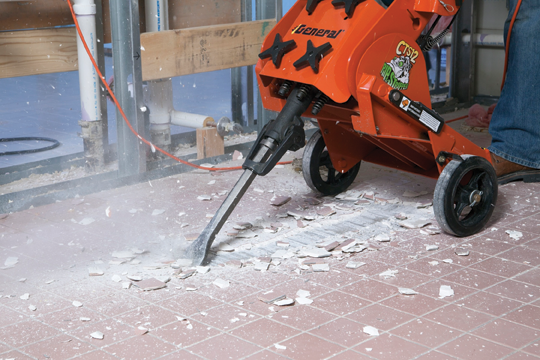Rental Solution
Floor Covering Removal Projects
The right system can help reduce costs, save time and go easier on your customers' crews
By Mike Crummy

Projects involving floor-covering demolition often require that contractors get down on their hands and knees, using a rotary hammer to chip away the covering. It’s a tedious job that can be physically demanding and time consuming.
An alternative to handheld units, General Equipment’s CTS12 Rip-R-Stripper serves as a tool carrier for electric-powered breakers – rotary hammers with ratings between 30 and 45 foot-pounds of force, including Hilti, Bosch, Makita, DeWalt and Hitachi models. Unlike random orbit-type tile stripper machines, this system delivers a direct-impulse force to break through the high bond strengths of mastics, glues and thin-set materials – all with the operator standing up. It’s easy to maneuver the equipment and physically goes easier on contractor customers.
Rental solution
John Simon of Simon Rents in Monrovia, Calif., has had a CTS12 in his fleet for about two and a half years. It’s rented in combination with a Bosch electric breaker. “Previously we would rent out a chipping hammer with a special blade for tile or wood,” Simon points out. “You had to hold it by hand and bend over. Even with two guys taking turns, it would wear them out. With this, you stand behind it and one guy pushes. So it saves on the physical toll and in some cases cuts the customer’s labor expense in half.”
Tony Beringer, of Baker Equipment Rentals in Costa Mesa, Calif., also rents the system with a Bosch breaker equipped with a three-inch-wide chisel. “This was a good addition to our offering,” he comments. Baker carries three other options for floor stripping jobs, including a 1,000-pound ride-on machine. The advantage of this system, he notes, is that operators “can grab two handles and stand up while doing the job. It certainly beats getting knee pads and crawling around on your hands and knees.”
At Ventura Rental Center in Ventura, Calif., Mark Dean has two CTS12 units in the fleet, each paired with a Hitachi H65 Series hammer. “It’s a perfect tool for removing heavy ceramic tile,” Dean says. “Everybody is really happy with it. The cart’s purpose is to save on the backaches that are common when you’re down on the ground with a hammer in your hand, and it serves that purpose very well. A back is a terrible thing to waste.”
Avoiding aches, pains, injuries and potential worker’s compensation claims have been easy selling points to rental customers. According to the rental centers, the other benefit to customers is being able to double productivity. “When you’re not down on your hands and knees, production is much quicker,” Simon comments. “Most people are getting the job done twice as fast.”
Dean and Beringer reported similar gains in productivity and efficiency for their customers. “If they get the machine going at the correct angle, it moves along really well,” Beringer explains. “That’s the thing we really try to point out. Find yourself an area where you can position your angle right, and you’ll make much quicker work of the job.”
Given their experience with the difficulty of this particular customer application, all three rental operators also expressed appreciation for the overall design and durability of the solution, making it an ideal fit for a rental fleet. “The units we have are certainly built rental tough,” Dean states. “It’s pretty hard to ruin it. They’re heavy-duty and made for the tool.”
Happy customers
Rental centers have been only too happy to have it on hand and ready to solve common problems. “I love it when a guy says they’ve got really thick tile on a concrete floor and wonder how they’re going to get it off,” Dean says. “I just get a smile on my face and show them that machine. And they can see right away that it’s a great solution. They know it’s going to work just by looking at the setup. It’s pretty self-explanatory on how to use it.”
Beringer says that customers need equipment from him about once a week on average for ceramic tile or paver removal, and the product fits in well with his other offerings. “You encounter variations from job to job, so it’s great that we’ve added another alternative, another choice. The people who have used it generally come back and get it again.” According to Simon, one customer drove 50 miles to rent the machine, since he couldn’t find anything similar nearby, for the purpose of bringing it all the way to a casino renovation job in Reno, Nev. The project was being done in phases, so the contractor rented the unit twice, for a full week each time.
According to Simon, one customer drove 50 miles to rent the machine, since he couldn’t find anything similar nearby, for the purpose of bringing it all the way to a casino renovation job in Reno, Nev. The project was being done in phases, so the contractor rented the unit twice, for a full week each time.
“It’s a well thought-out machine,” Simon contends. “Customers have told me they wish it had been available five years ago. It basically complements our other rental equipment, too. After they rent this machine, they’ll come back and get a surface grinder to clean up the mastics or the glues.”
The CTS12 has even ventured outside its normal scope of removing tile and wood flooring to solve other problems. Dean once received a call from another rental store inquiring about rust removal. “We’re close to a harbor, and they were looking for something that could remove rust from the deck of a tugboat,” he says. “I showed them our machine, and they loved it. They came again for a two-day rental, and then the next time they kept it for a week.”
Full-time benefits
Both Dean and Beringer reported that a few regular rental customers eventually decided the benefits of the machine warranted a purchase. That’s a familiar story for Mark Jones, an end-user who rented the machine before purchasing one later.
President of Commercial Tearout Services, in Spokane, Wash., Jones and his crew had always spent a large percentage of time on their hands and knees. Understandably, this took a toll on their bodies, as well as the company’s efficiency. Eventually, it led Jones to experiment with new rental equipment for his floor-covering removal jobs.
“We remove glue-direct carpet, sheet vinyl, ceramic tile, vinyl composition tile and wood flooring,” Jones explains. “Occasionally, we remove specialty floor coverings, too.” The company owns an electric-powered ride-on machine equipped with a front-mounted, two-inch-wide carbide blade, which is designed to quickly ‘pop’ the tiles. However, weighing in at nearly a ton, it’s not well suited to small rooms.
The company’s main frustrations arose from a job at a local Air Force base where they were removing tile from a dormitory floor. Of the five floors in each building, only two could be accessed with a ride-on machine. Therefore, Jones and his crew used hand-held rotary hammers to remove tile from the remaining three floors. “There was about 4,000 square feet of tile per building. That’s a lot to do on our hands and knees.”
Jones happened to learn about the CTS12 just as another job was coming up at the airbase. He tracked down a rental store a couple hours from Spokane that had a unit available. It worked just as he hoped it would. “It takes a lot of load off your knees and back, so an operator can run it for longer periods of time,” Jones says. “And because you’re standing up, it keeps your eyes and ears farther from the operation, instead of having your face 16 inches from the floor.”
Much like the calculations that Simon, Dean and Beringer reported, Jones determined that the machine could remove tile at least twice as quickly as hand-held rotary hammers. “When we first used it, we took up between 1,600 and 2,000 feet of tile,” says Jones. “The machine hits much harder than a rotary hammer and, because of the way the breaker sits in the carriage, the operator doesn’t need to manhandle it. Being able to adjust the angle is equally important because the operator works at many different angles to stay underneath the tile without digging into the slab.”
Due to his success renting the equipment, Jones gradually realized the full potential and best applications for the product, eventually adding one to the ride-on equipment and hand-held rotary hammers he already owns. Is that the ideal outcome for a rental center? “The bottom line is that we want people to leave here satisfied with the equipment they have rented,” says Dean. “We’re in the business of making happy customers. And if we succeed, everyone wins.”
Mike Crummy is a writer with The Promersberger Company. Background informatoin for this article provided by General Equipment company (www.generalequip.com).
Originally published in the May/June 2014 issue of Pro Contractor Rentals. Copyright 2014 Direct Business Media.








